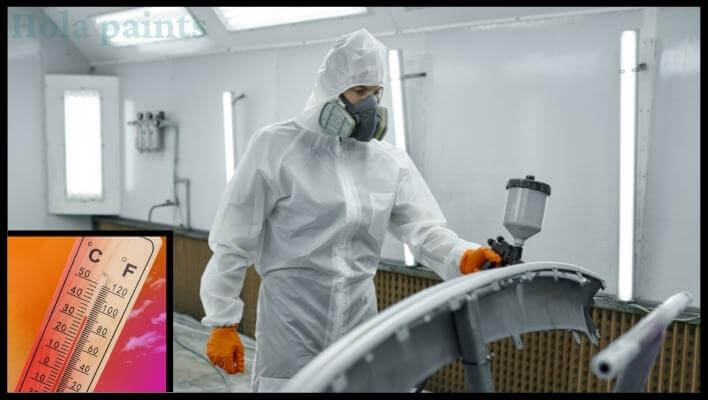Enter into the picture; spray painting is an expedient and well-timed way to handle small or big painting projects. If you have previous experience for using a sprayer, you will be well aware of its parameters. It requires several factors to consider before finalizing it to get a planer finish. Not to mention, spray painting temperature is one of the most crucial aspects of getting a high-quality finish.
Remember that minute changes in temperature directly strike the spray paint, and you might get totally varied results. The paint flow, atomization, and finishing get affected even with a 1-degree change in temperature. This short guide covers spray paint temperature rating and other relevant information. So, let’s get started!
Table of Contents
- Ideal Spray Painting Temperature
- What Happens with Spray Painting If It’s Too Hot?
- Can I Spray Paint In 40 Degrees?
- Can I Spray Paint In 50 Degrees Weather?
- Spray Paint Temperature Celsius
- How do I maintain the Spray paint temperature?
- Best Temperature To Spray Paint Metal
- Best Temperature To Spray Paint A Car
- Spray Paint Temperature Of Brands
- FAQs On spray Paint temperature
- Is it OK to spray paint in cold weather?
- What temperature is too cold for spray paint?
- What happens if you paint when it’s too cold?
- Final Thoughts On Spray Painting Temperature
Ideal Spray Painting Temperature

It’s true that the different types of liquids change with the change in temperature. Our point of concern is the viscosity of the fluids. When the temperature is cold, you feel the liquids thicker than before, such as honey, oil, peanut butter, syrup, or other liquids.
On the other hand, they become thin with the increase in temperature when the viscosity decreases. In short, temperature and viscosity have indirect relations. Spray paint or ordinary paint is also a liquid and changes its viscosity with temperature.
The ideal spray painting temperature is between 50°F and 90°F when the relative humidity is less than 85%. So, keep this ideal temperature range in mind if you are planning to do spray painting. Also, take additional painting precautions such as direct sunlight exposure, high humidity, etc.
What Happens with Spray Painting If It’s Too Hot?
The spray paint viscosity declines with the increase in temperature. The paint becomes thin, you start observing drips, and start flowing more easily. Such conditions cause paint waster and the chances of bigger messes increase. When it’s too hot beyond a particular range, it will not stick to the walls.
The reason is that the paint will dry before reaching the targeted surface. The common signs are peeling off surfaces and the uneven look of the paint on the walls.
Can I Spray Paint In 40 Degrees?
You can spray paint at 40 degrees but not when it falls below this threshold. It is not recommended by the paint manufacturers, especially for oil-based paints and also professional painters. At this temperature, you will feel the paint thicker when applied.
It will cause bumps and bubbles after a while on the painted surface. There are also chances that the paint sprayer stops working due to clogging.
Nowadays, most paint manufacturers mention the threshold temperature for your ease. You can apply the exterior paint as long as it does not fall below 35 degrees.
Can I Spray Paint In 50 Degrees Weather?
According to the experiments conducted by manufacturers and professionals, 50 degrees is not a suitable temperature for spray painting. The humidity at this particular temperature affects the paint’s overall condition.
It might not be able to cure properly, and exceeding moisture amounts cause it not to stick with the surface. There is also a possibility that the paint will not dissolve completely if you are using water or oil-based paints.
Spray Paint Temperature Celsius
Different regions measure temperature in different units, such as Celsius and Fahrenheit. Usually, people also ask about the spray painting temperature range in Celsius. So, the effective range of spray paint temperature in Celsius is 18℃ to 25℃. However, it’s necessary to take safety precautions and moisture measurements before spray painting.
How do I maintain the Spray paint temperature?
My experience with spray painting booth is fantastic! The spray painting booth is one of the best ways for me to control the temperature when spray painting.
The booth allows for precise settings for heat and humidity and does not depend on weather conditions.
A booth creates the ideal environment for spray painting onto any product or spray booth creates an environment that promotes smooth, even and fast-drying spray painting of any product.
The spray painting booth prevents dust from sticking to our products and prevents them from being marked, while also removing fumes from solvents.
Best Temperature To Spray Paint Metal
Metals are widely used in household works, industrial tasks, and for manufacturing several things. Spray paint on metal helps protect it from hard weather conditions and ensures long-lasting performance. Like other materials, you can get the best spray paint finish when you paint it at a suggested temperature range.
The suitable temperature to spray paint metal is 50-90 degrees Fahrenheit or 10-32 degrees Celsius. When you spray paint in this range, you will get the best painting results.
Best Temperature To Spray Paint A Car
Automotive paint is different from an ordinary wall or ceiling paint. It requires it to be more adhesive and sturdy to bear the harsh weather conditions. Instead, it also has a specified range to ensure the desired spray paint results.
The suitable temperature to paint a car is 55 degrees Fahrenheit, and the upper range is 70 degrees Fahrenheit. Likewise, this temperature is satisfactory at a 50% humidity level.
Spray Paint Temperature Of Brands


FAQs On spray Paint temperature
Is it OK to spray paint in cold weather?
Yes, it’s perfectly fine to paint in cold weather when the temperature does not fall below the specified range. If the temperature range is 50°F and 90°F, you are good to go with spray paint.
What temperature is too cold for spray paint?
The threshold temperature for spray paint is 50°F and 90°F. When the temperature falls below, we call it too cold. The professionals and manufacturers do not recommend paint below the mentioned temperature; otherwise, you will get poor results.
What happens if you paint when it’s too cold?
When the paint is too cold, it does not cure properly even after several days. In the cold, the weather makes the paint evaporate and dry slowly. It becomes less resistant to cracking till it dries completely. If the moisture is high, staining and mildew are common.
Final Thoughts On Spray Painting Temperature
In conclusion, when it comes to spray painting temperature, there are various factors to consider to get high-quality finish. High temperature is not good for spray paints as it results in poor painting results. Therefore, always paint the walls, ceilings, metals, or any other material when the weather is under the standard temperature and humidity ranges.

Jennifer Marie
Jennifer Marie is a general contractor with over the years of experience in home remodeling, DIY projects, and commercial painting projects. Her experience includes working with paint sprayers, painting tools, and other painting supplies. You can follow her on Facebook.


